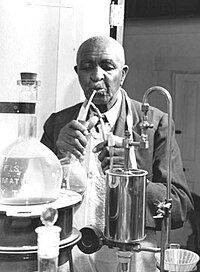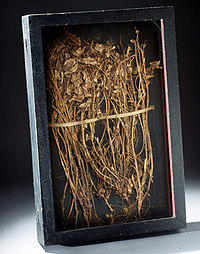George Washington Carver
George Washington Carver (c. Spring of 1864 – January 5, 1943) was an African American botanist who worked in agricultural extension in the Southern United States. He taught former slaves farming techniques for self-sufficiency and is known for suggesting hundreds of uses for the peanut and other plants to increase the profitability of farming.
Early years
Carver was born into slavery in Newton County, Marion Township, near Diamond Grove, now known as Diamond, Missouri. The exact date of birth is unknown due to the haphazard record keeping by slave owners but "it seems likely that he was born in the spring of 1864" [1]. His owner, Moses Carver, was a German American immigrant who had purchased George's mother, Mary, from William P. McGinnis on October 9, 1855 for seven-hundred dollars. The identity of Carver's father is unknown but he believed his father was from a neighboring farm and died "shortly after Carver's birth...in a log-hauling accident" [2]. George had three sisters and a brother, all of whom died prematurely.
When George was an infant, he, a sister, and his mother were kidnapped by Confederate night raiders and sold in Arkansas, a common practice. Moses Carver hired John Bentley to find them. Only Carver was found, orphaned and near death from whooping cough. Carver's mother and sister had already died, although some reports stated that his mother and sister had gone north with the soldiers. For returning George, Moses Carver rewarded Bentley with his best filly that would later produce winning race horses. This episode caused George a bout of respiratory disease that left him with a permanently weakened constitution. Because of this, he was unable to work as a hand and spent his time wandering the fields, drawn to the varieties of wild plants. He became so knowledgeable that he was known by Moses Carver's neighbors as "the plant doctor."
One day he was called to a neighbor's house to help with a plant in need. When he had fixed the problem, he was told to go into the kitchen to collect his reward. When he entered the kitchen, he saw no one. He did, however, see something that changed his life: beautiful paintings of flowers on the walls of the room. From that moment on, he knew that he was going to be an artist as well as a botanist.
After slavery was abolished, Moses and his wife Susan raised George and his brother Jim as their own. They encouraged Carver to continue his intellectual pursuits. Aunt Susan taught him to read some words and write his name.
Since blacks were not allowed at the school in Diamond Grove and he had received news that there was a school for blacks ten miles south in Neosho, he resolved to go there at once. To his dismay, when he reached the town, the school had been closed for the night. As he had nowhere to stay, he slept in a nearby barn. By his own account, the next morning he met a kind woman, Mariah Watkins, from whom he wished to rent a room. When he identified himself "Carver's George," as he had done his whole life, she replied that from now on, his name was "George Carver." George liked this lady very much and her words "You must learn all you can, then go back out into the world and give your learning back to the people," had a great impression on him.
At the age of thirteen, due to his desire to attend high school, he relocated to the home of another foster family in Fort Scott, Kansas. After witnessing the beating death of a black man at the hands of a group of white men, George left Fort Scott. He subsequently attended a series of schools before earning his diploma at Minneapolis High School in Minneapolis, Kansas.
After high school, George started a laundry business in Olathe, Kansas.
College years

Over the next few years, he sent letters to several colleges and was finally accepted at Highland College in Highland, Kansas. He travelled to the college, but was rejected when they discovered he was black. In 1887, he was accepted to Simpson College in Indianola, Iowa, as its first African-American student (some reports cite the year as 1890 and that he was, in fact, the second black student accepted at Simpson). He transferred in 1891 to Iowa State University (then Iowa State Agricultural College), where he was the first black student, and later the first black faculty member.
In order to avoid confusion with another George Carver in his classes, he began to use the name George Washington Carver.
While in college at Simpson, he showed a strong aptitude for singing and art. His art teacher, Etta Budd, was the daughter of the head of the department of horticulture at Iowa State: Joseph Budd. Etta convinced Carver to pursue a career that paid better than art and so he transferred to Iowa State.
At the end of his undergraduate career in 1894 and recognizing Carver's potential Joseph Budd and Louis Pammel convinced Carver to stay at Iowa State for his master's degree. Carver then performed research at the Iowa Agriculture and Home Economics Experiment Station under Pammel from 1894 to 1896 when he graduated. It is his work at the experiment station in plant pathology and mycology that gained him national respect as a botanist.
The encouragement Etta Budd gave Carver to seek a better-paying career was well warranted, at least for Etta, since she died a poor retired art teacher in a Boone, Iowa retirement home.
Later years
In 1896, he was recruited to Tuskegee Normal and Industrial Institute (today: Tuskegee University) by Booker T. Washington in Tuskegee, Alabama. He remained there for 47 years until his death in 1943.
Taking an interest in the plight of poor Southern farmers working with soil depleted by repeated crops of cotton, Carver advocated employing the nitrogen cycle by alternating cotton crops with other planting, such as legumes (peanuts), or other crops (sweet potato) to restore nitrogen and other nutrients to the soil. Thus, the cotton crop was improved and new cash crops added. He developed an agricultural extension system in Alabama — based on that created at Iowa State University — to train farmers in raising these crops and an industrial research laboratory to develop uses for them.

In order to make these new crops profitable, Carver devised numerous uses, several of which were unique, for the new crops, including more than 300 uses for the peanut. These applications included glue, printer's ink, dyes, punches, varnishing cream, marble, rubbing oils, and Worcestershire sauce; however, contrary to popular belief, this list does not include peanut butter.[3] He made similar investigations into uses for plants such as sweet potatoes and pecans.
Until 1915, Carver was not widely known for his agricultural research. However he became one of the best-known African-Americans of his era following the funeral of Booker T. Washington when he was praised by Theodore Roosevelt. In 1916, he was voted in as a member of the Royal Society of Arts in England, one of only a handful of Americans at that time to receive this honor. By 1920 with the growth of the peanut market in the U.S., the market was flooded with peanuts from China. That year, Southern farmers came together to plead their cause before a tariff hearing. Carver was elected, without hesitation, to speak before the hearing. On arrival Carver was mocked but was not deterred and began to show them some of uses he had found. He was initally given ten minutes to present, but the committee extended his time again and again. The committee was held spellbound and rose in applause as he finished his presentation. The following year a tariff was placed on imported peanuts.
Now Carver was famous. Business leaders came to seek his help and he always gave it to them without a price. Three American presidents — Theodore Roosevelt, Calvin Coolidge and Franklin Roosevelt — met with Carver. The Crown Prince of Sweden studied with him for three weeks; Indian leader, Mahatma Gandhi too was in his company for a while. Carver's best known guest was Henry Ford who built a laboratory for Carver and conducted research with him there as well. Their most notable discovery together was regarding the fabrication of rubber. Carver also did extensive work with soy, which he and Ford considered as an alternative fuel. Carver created a soy-based plastic still used in automobiles today for its dent-proof qualities.
In 1923, Carver received the Spingarn Medal by the NAACP, awarded annually for outstanding achievement. In 1928, Simpson College bestowed Carver with an honorary doctorate. In 1940, Carver established the George Washington Carver Foundation at Tuskegee University. In 1941, the George Washington Carver Museum was dedicated at the Tuskegee Institute. In 1942, Carver received the Roosevelt Medal for Outstanding Contribution to Southern Agriculture.
Death and afterwards
Upon returning home one day, Carver took a bad fall down a flight of stairs; he was found unconscious by a maid who took him to a hospital. Carver died January 5, 1943 at the age of 79 from complications (anemia) resulting from this fall.
On his grave was written the simplest and most meaningful summary of his life. He could have added fortune to fame, but caring for neither, he found happiness and honor in being helpful to the world
On July 14, 1943 [4], President Franklin Delano Roosevelt dedicated $30,000 for the George Washington Carver National Monument west-south-west of Diamond, Missouri - an area where Carver had spent time in his childhood. This dedication marks the first national monument dedicated to an African-American. At this 210 acre national monument, there is a bust of Carver, a 3/4 mile nature trail, a museum, the 1881 Moses Carver house, and the Carver cemetery.
Carver appeared on US commemorative stamps in 1948 and 1998 and was depicted on a commemorative half-dollar from 1951 to 1954. The USS George Washington Carver (SSBN-656) is also named in his honor.
In 1977, Carver was elected to the Hall of Fame for Great Americans. In 1990, Carver was inducted into the National Inventors Hall of Fame. Iowa State University awarded Carver the Doctor of Humane Letters in 1994. On February 15, 2005, an episode of Modern Marvels included scenes from within Iowa State University's Food Sciences Building and about Carver's work. Many people honor George Washington Carver to this day.
George Washington Carver in Films
In the 2002 movie Undercover Brother, Conspiracy Brother, played by Dave Chapelle, laments how black people don't get credit for anything. To make his point, he claims, "Did you know that George Washington Carver made the first computer from a peanut?"
See also
References
- McMurry, L. O. Carver, George Washington. American National Biography Online Feb. 2000
- ^ Pages 9-10 of George Washington Carver: Scientist and Symbol by Linda McMurray, 1982. (ISBN 0195032055)
- ^ Page 10 of George Washington Carver: Scientist and Symbol by Linda McMurray, 1982. (ISBN 0195032055)
- ^ http://www.nps.gov/gwca/index.htm
- Carver, George Washington. "1897 or Thereabouts: George Washington Carver's Own Brief History of His Life." George Washington Carver National Monument.
External links
